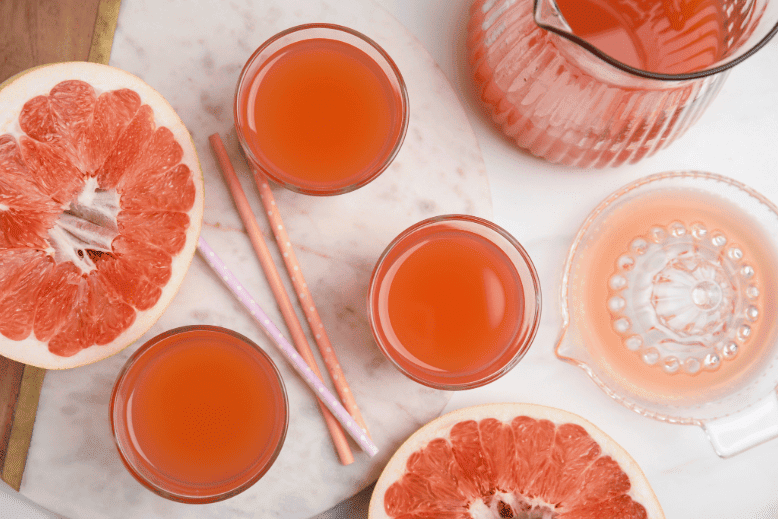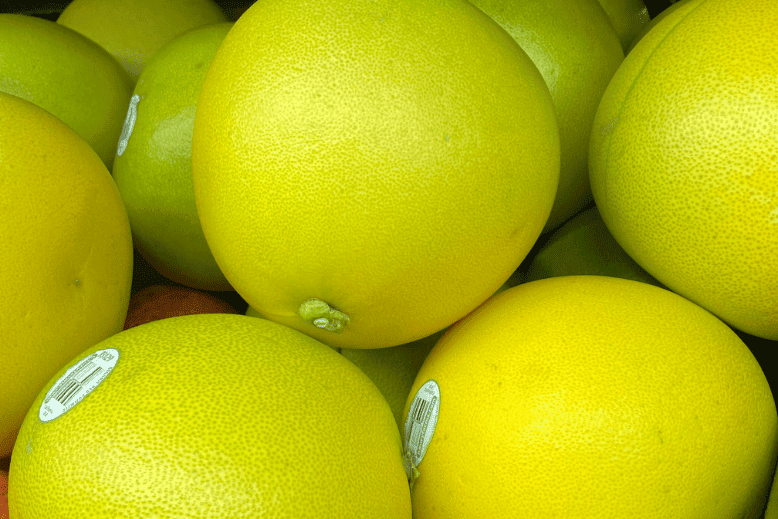
One of the things I love most about my job is the opportunity to help educate people about fruits and vegetables that they might not be as aware of or familiar with. Pummelos are one of those items, and I think you’ll find that they’re absolutely worth a taste!
FUN FACTS ABOUT PUMMELOS
Hailing from the family Rutaceae and native to southeast Asia, the pummelo is the largest of the citrus fruits and is a relative/ancestor of the grapefruit, but with some important differences. The first and most obvious difference between pummelos and grapefruits is their size. Pummelos have a thicker rind and—measuring 7 to 10 inches in diameter compared to 4 to 6 inches for grapefruits—are definitely larger than grapefruits (they can grow to the size of a cantaloupe or even a basketball!). Once peeled, however, the fruit inside is about the size of a grapefruit. Pummelos have yellow to light green rinds, an oval shape, and pale yellow or light pink flesh—while grapefruits have light orange to pink rinds, a much more rounded shape, and bright pink or red flesh inside. Finally, while they taste similar to grapefruits, pummelos are milder, sweeter and less bitter. The two fruits can be used interchangeably in cooking, but if the recipe calls for something sweeter, pummelos might be the best option.
Because they’re a member of the citrus family, pummelos are high in vitamin C and cancer-fighting antioxidants; they’re also rich in fiber (triggering a sense of fullness that can help promote weight loss) as well as potassium, which helps regulate blood pressure.
According to ethnic lore, pummelos symbolize family unity, prosperity and good luck in Chinese culture, especially during New Year celebrations, when pummelos are often given as temple gifts. Available in local stores now and in the coming weeks, this delicious and nutritious fruit can be a gift you give to yourself and others in commemoration of the upcoming Chinese New Year on February 10!
SELECTION & STORAGE

High in vitamin C, antioxidants and fiber, pummelos have a bright, tart and sweet flavor profile. Photo: Courtesy of Susan Bloom
Select pummelos that have a bright yellow or pale yellow color on their exterior, as that’s an indication of their ripeness and sweetness (though a bit of green is still okay). If their outer rind develops a tinge of pink, however, it’s overripe, and you should pass on it.
Pummelos stay freshest if they’re stored in a cool spot like the refrigerator or an unheated garage or basement. Happily, even if the fruit starts to get a little soft, its nearly one-inch-thick pith will keep it protected. The cooler you store the fruit (without going below 35-40 degrees Fahrenheit), the longer it will keep, which can be up to 4-5 weeks.
PREPARATION
You’ll want to cut your pummelo carefully to avoid its bitter rind and pith. Start by cutting off the top and bottom of the pummelo with a sharp knife, then use the knife to score around the pummelo a few times (incisions roughly one inch deep). Using your fingers, peel back the pith and rind, and pull the fruit out of the shell, removing as much of the pith as you can. Finally, break the pummelo apart into segments, removing the flesh from the membrane as you go (similar to the way you would with a grapefruit).
Grapefruit and pummelo segments can be used interchangeably in salads and slaws, as long as you remove the bitter pummelo skin and pith away completely.
A squeeze of pummelo or grapefruit juice can easily stand in for lemon juice in salad dressing or vinaigrette recipes and sauces, and is also a delicious addition to a classic paloma cocktail (featuring fresh grapefruit or pummelo juice, grapefruit or pummelo soda, and other ingredients such as simple syrup and tequila if desired).
Grapefruits and pummelos can even be used together in dishes that feature a variety of citrus fruits, such as a cirtus tart. And, of course, you can simply slice pummelos into segments and enjoy the fruit raw.
My friends at Sunkist, who make delicious pummelos available to the marketplace, have shared with me the following recipe for Pummelo Brulée, which will help you experience all of the bright, tart and sweet goodness that pummelos have to offer! Enjoy. I’m wishing you a great start to the new year.
PUMMELO BRULÉE
(courtesy of Sunkist)
- 2 Sunkist pummelos, halved
- ½ cup granulated sugar (or to taste)
- 2 dollops Greek yogurt for topping (optional)
Preheat broiler or oven to high. Trim a small amount of peel from the bottoms of each pummelo half to stabilize the fruit so that it can sit flat. Place halved pummelos on a baking sheet, cut side up. Cover the exposed pummelo flesh with a thin, even layer of sugar—2 tablespoons per half, using more as needed (if desired) to cover the flesh. Place the four halves under the broiler until the sugar has bubbled and caramelized; this should take about five minutes, but keep a close watch, as the sugar can burn very quickly. Remove pummelo halves from oven and allow to cool for 10 minutes before serving. Add a dollop of yogurt (if desired) and enjoy!
About “Produce Pete” Napolitano
With over 70 years of experience in the produce industry, New Jersey’s own “Produce Pete” Napolitano is a renowned fruit and vegetable expert, author and TV personality who’s appeared on a highly popular segment on WNBC’s Weekend Today in New York, every Saturday morning for over 30 years. For more information, visit producepete.com.
About Susan Bloom
A regular contributor to New Jersey Monthly and a variety of other well-known local and national publications, Susan Bloom is an award-winning New Jersey-based freelance writer who covers topics ranging from health and lifestyle to business, food and more. She’s collaborated with Produce Pete on a broad range of articles for over a decade.
Pete and Susan are the coauthors of Pete’s award-winning memoir/cookbook, They Call Me Produce Pete, available on Pete’s website and wherever books are sold.
No one knows New Jersey like we do. Sign up for one of our free newsletters here. Want a print magazine mailed to you? Purchase an issue from our online store.
